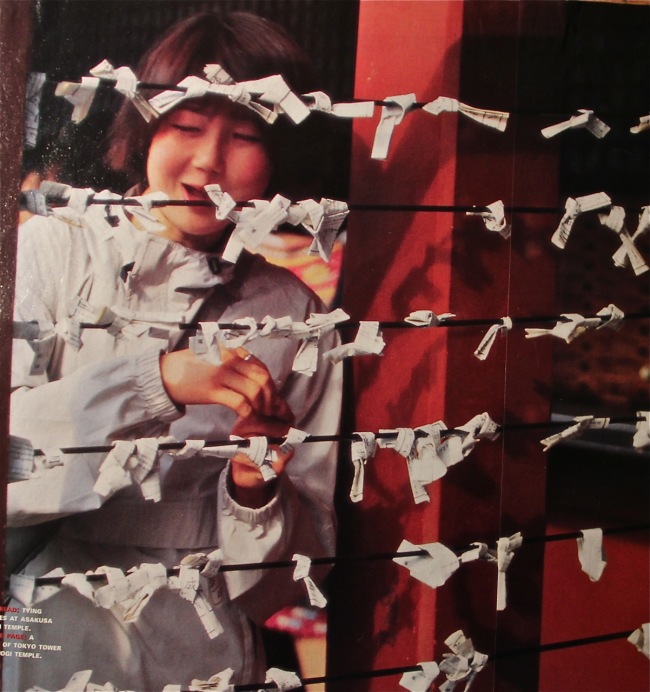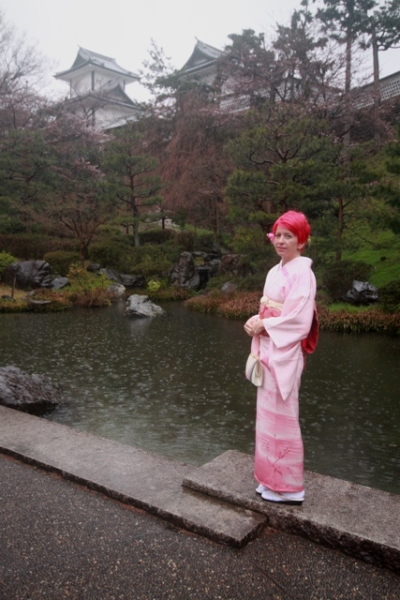Bringing home travel purchases is an age-old tradition and one that Michael and Laurie Vander Velde have passed on to new generations with personal significance and a story behind it.
All tagged Japan
The Horror Of Hiroshima
Executive editor Judith Fein went to Hiroshima, Japan, where the first nuclear bomb was dropped. As nuclear threats are once again appearing in the news cycle, Fein reminds us about what a nuclear bomb and its aftermath were really like.
Homeward Bound
by Angela Smith Kirkman
As far back as I can remember, my life’s goal has been to travel around the world. Now, as I sit in row twenty-two of our Boeing 777, chasing the moon over the Pacific somewhere between Tokyo and the International Date Line, I can feel the book closing on this chapter, on the whole epic adventure. And the same question keeps resonating in the back of my mind.
In the mid-90s, I was living and working as an ESL teacher at a private school in Kanazawa, Japan, a couple of hours by train from my relatives living in Kobe. I liked to visit them at least once a month to get to know them and stave off homesickness. The train ticket usually cost about $150. Sometimes I took the bus to save money, even though it was a much longer trip.
One day, our office boy, Kazu (who also worked part-time for a travel agency) told me that he could get me a free ticket to Kobe that weekend. He was booking a chartered bus which had an empty seat. The only catch, he explained, was "Overnight bus. Maybe you be tired." I said sure, that would be fine, "I can sleep on the bus." He gave me a quizzical look and said, "Ahhh...no sleep." As a foreigner, I was by then used to getting quizzical looks from the locals, so I didn't comment or think much about his hesitation.
When the weekend came, my boss and his wife offered to drive me to the bus station. "So, Kazu got you on the overnight bus. Have you ever taken overnight bus before? You might be too tired when you get there." I said that I had taken other overnight buses and I could always fall asleep. "Hm. I guess you won't sleep," my boss said. I assumed he figured it would be too uncomfortable, so again I said nothing.
They dropped me off and said, smirking, "Okaaaay...have a nice trip. Let me know how you sleep." In retrospect, I should have wondered why they were smirking.
Christmas in Kyoto did not sound promising but the flight was cheap. Having spent the last several Christmases huddled around the small wooden tables of the German Weihnachtsmarken, hands wrapped tightly around steaming ceramic mugs of glühwein, we expected Japan to be a bit of a disappointment in terms of holiday spirit.
There would be no Christmas markets selling roasted sausages or over-sized steins of altbier. There would be no outdoor festival tables to provide the inevitable camaraderie that accompanies the mass consumption of mulled wine in freezing temperatures. Communication would be near impossible as both my wife Lauren and I spoke very little Japanese and could not read kanji or katakana.
Nonetheless, one evening as we approached the bottom of our second bottle of wine, we decided Kyoto would make for a fine introduction to Japanese culture, with the added bonus of seeing drunken Japanese “salary men” stumbling around in Santa hats.
Fish and Friendship in Tokyo
by Jules Older
On our last visit to Japan:
- An American businessman told me, “A bunch of hippies got together for three days and took drugs.” He was talking about Woodstock.
- We looked out the window of our ryokan and gazed upon a 13th-century pagoda. On the television in our traditional Japanese room, man was taking the first steps on the moon.
- And our twin daughters were conceived on a futon in Tokyo.
* * *
It was to Tokyo we were returning, decades later. Our friends – Eipan and Hirame, Eiichi and Hiroko – still lived there, and it was way past time to re-une. And we wanted to see the city we’d been so taken with all those years before. How had it changed? How had it not?
When I tell Hirame on the phone that I’m looking for changes, she says, “Expect to see a lot of blonde Japanese.”
I chuckle. “Not your daughters, I bet.” Despite his years as a grad student (and my roommate) in New York, Eipan is very traditional, a samurai businessman with a 6th degree black belt in Judo. I can hear Hirame’s quiet smile all the way from Tokyo. “They’re brown-hair Japanese.”

It doesn’t take long to spot other changes, other sames. First stop on the bus trip in from the airport is the La Floret Hotel. As the bus doors open, a young woman in a sharply pressed uniform bows deeply. Score one for the same. On the other hand, where the massive hotel – and dozens like it – now stand, there used to be only small shops. The Tokyo skyline has pushed skyward.
At our friends’ home, there’s a similar mixture. We still take off our shoes at the door, but Hirame greets us with a kiss, not a bow. The ofuru, the ubiquitous Japanese hot tub, still awaits, only now it’s kitted out with bubbles, programmable water jets and digital temperature controls that can be operated from the kitchen.
Use It Or Lose It: A Japanese Tea Story
Thirty years ago, I was dazzled by my action-packed month visiting a friend and his family in Japan. They live in Fukui Prefecture near the Sea of Japan, but I gazed in wonder at the Gion Festival and temples in Kyoto, kabuki theater in Tokyo, the deer park in Nara and Himeji castle from Shogun days. The most delicate and intimate thing I recall was a tea ceremony performed by a friend of my friend at her home.
Turning Japanese
“No photos with coat,” she instructs my photographer husband with a smile. The petit, pigeon toed, doll-like figure clad in a silky red, black and white kimono is ever so polite but adamant about him not taking any photos of me while I am wearing the box-shaped overcoat.
 Photos in the kimono are allowed and encouraged but almost forbidden if the kimono-clad woman is wearing an overcoat. I bow slightly and smile while nodding affirmatively. I feel and look like a modern version of an obedient Japanese woman.
Photos in the kimono are allowed and encouraged but almost forbidden if the kimono-clad woman is wearing an overcoat. I bow slightly and smile while nodding affirmatively. I feel and look like a modern version of an obedient Japanese woman.
It’s my 40th birthday and I’m about to hit the streets of Kanazawa, the small castle city on Japan’s main island of Honshu that is northwest of Osaka. I am a bit nervous to be going out amongst the Japanese people: a Westerner with pink hair wearing the beloved kimono.
So you probably want to know what I am doing in the kimono under an overcoat in Japan, and who says I can't be photographed in an overcoat. Actually, it started two hours ago. When I arrive for my one o'clock appointment, I notice the foyer is lined wall to wall with shoes and slippers, like many Japanese households. It is customary to remove footwear and swap your shoes for a pair of slippers before entering.
Haruka, the young owner of the kimono rental shop greets us with many bows and the familiar “Irrashimasse” (welcome), a word that is used by many shopkeepers as you enter their shops or to entice you to enter their shops.
We duck through the noren (door covering), and enter the main sitting area. A low set table with red cushions as seats is in the middle of the room. Pictures of kimono-wearing woman, mostly Japanese, adorn the shelves and table tops.
Haruka shuffles through the paper-panelled sliding doors and disappears up a dark staircase. I follow her, using my hands to climb my way up the steep passageway. The room at the top is bright and airy. This is where the kimonos live.
The shelves are covered with delicate fabrics and laid out in color–coded piles. Haruka points out which ones are for springtime--pastel pinks, soft blues, yellows and purples; some with delicate features or intricate designs lie before me. I’m drawn to the pinks.
I choose a soft, pink silk kimono that gradually darkens as the material reaches the calf area. The fabric is designed with sporadic branches and leaves, similar to sakura (cherry blossom). I feel like a little girl playing dress-up.
Since childhood, everything about Japan has enthralled me: food, traditional clothing, bonsai trees, ikebana floral arrangements and, of course, the people themselves. The poster in the window showed verdant, bucolic rice paddies being tended by women in traditional bonnets and straw hats. For dramatic relief, a snowcapped mountain hung in the background and the caption promised that I would “See the real Japan. Become immersed in the mysterious Orient by cycling the back roads of rural Shikoku – an island that outsiders rarely visit.”
It took about a nanosecond for me to walk into the travel agency and pay a deposit.





